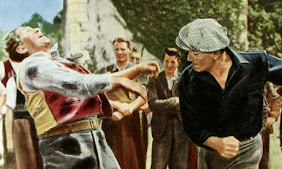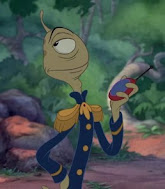When the Valentines season comes to an end, and St. Parick’s Day on the horizon, one of my favorite movies to watch as part of the transition is the 1952 Romance classic “The Quiet Man”. It’s both a wholesome love story, and the very first American picture to be shot in the lush green, picturesque countryside of Ireland. Director and producer John Ford made a name for himself with a number of successful Westerns, along with his leading star John Wayne, and for years he had a passion project to make a movie that was essentially a love letter to his home roots in the Emerald Isle. He teamed up with screen writer Frank S. Nugent, who based the script on a 1933 short story from the Saturday Evening Post titled “The Quiet Man”, which was a story from a collection titled “The Green Rushes”.
The movie follows American Boxer Sean Thorton, who’s sworn off fighting after a tragic accident in the ring and now aims to have a quiet life in the Irish town of his birth. Upon arrival, he makes friends with the locals, and catches the eye of the lovely Mary Kate, who’s his next-door neighbor. Unfortunately, Kate’s older brother, the Squire “Red” Will Danaher is a town bully, and is quick to make rivalry with the newly arrived Thorton. As time passes, Thorton and Mary Kate gradually fall in love, and eventually get married, but as their romance blossoms Will Danaher’s anger grows, refuses to give a marriage blessing, and hordes her dowry to himself. As conflicts arise, it seems likely that Thorton will have to fight his rivel … which after his disaster in the boxing ring is the last thing he wants.
While director John Ford had great success with his Westerns, most of the major studios turned down his pitch for a romantic picture set in Ireland. His last chance for a studio was “Republic Pictures”, who mainly distributed B-Movies and B-list Westerns. Thus, a deal was made, if John Ford made them a profitable Western, they’d finance his Irish picture.
Ford made them the 1950 picture “Rio Grande”, which was a capper to what’s known as the directors “Cavalry Trilogy” … his previous two films being “Fort Apache” in 1948 and “She Wore a Yellow Ribbon” in 1949. The film was profitable enough for “Republic” to finance his passion project, but the real take-away from Fords experience with “Rio Grande” was the pairing of his two romantic leads ... John Wayne and Maureen O’ Hara. Their fiery chemistry was just what he envisioned for the characters of Sean Thorton and Mary Kate, and thus, John Wayne and Maureen O’Hara were his leads again in “The Quiet Man”. John Ford would also direct them both as a romantic pair for a third time in the 1957 film titled “The Wings of Eagles”.
Both John Wayne and Maureen O’Hara would act in two more movies together … “McLintock!” in 1963 and “Big Jake” in 1971. I’m partial to their later two films myself, but most would agree that “The Quiet Man” is their golden classic as an acting pair. In general, Maureen O’Hara was always my favorite of John Waynes reoccurring costars. In “The Quiet Man” their chemistry is just as charming as ever and both make their respected characters come to life.
Of course, their most famous scene is their first kiss in a barn, amidst a strong windstorm. Even if you’ve never seen this movie, you’re probably still familiar with this scene on some level … largely thanks to a little Sci-Fi from 1982 called “E.T. The Extra-Terrestrial”. It was sheer genius for director Steven Spielberg to use this clip from “The Quiet Man” as a parallel to Eliots famous frog scene at school in the film. I could honestly spend this whole review highlighting memorable moments between these two, including a quiet walk through the country, which transitions into a fun bike ride, and culminates in them getting caught in the rain.
Not to be overlooked is Victor McLaglen as the antagonistic Squire “Red” Will Danaher, who’s portrayal garnered him an Oscar nomination for Best Supporting Actor.
One of my favorite characters is the local priest Father Peter Lonergan, who’s played by Ward Bond. He has a lot of personality and highlights how a priest can have a life outside of the church, like going out fishing and getting excited for a match-up. One of my favorite little scenes is when he and Mary Kate have a little excitement catching a fish together. The whole community has a lot of personality on display, and there’s a number of details that add a lot of character to the setting. I like how the members of the local pub always seem to have a song ready to go, with an accordion player on standby. One could argue there's more Irish stereotypes featured as opposed to real people from Ireland, but the lively characteristics on display lend to the films witty tone. There’s actually a decent amount of comedy, which transitions into full-on slapstick in the film’s final act when the two men finally have their big fight. Despite the darker elements of the boxer’s backstory, I’m glad this final fight is more light-hearted and fun in tone.
Naturally, the film was shot in Ireland (with interior sequences and Green-Screen shots in LA) … less known however is the village of Cong, in the County of Mayo, which is where the outside events of the film are set. Most of it was shot on the grounds of Cong’s Ashford Castle, which still celebrates the film today, with a statue of John Wayne and Maureen O’Hara on display.
It goes without saying that the film is gorgeous to look at, with all the beautiful locations and green landscape of Ireland on full display. Cinematographer's Winton C. Hoch and Archie Stout had an eye for details, and their work on the film won them the Academy Award for Best Cinematography. Director John Fords passion for his film project also paid off, as he too won the Academy Award for Best Director. The film received other Oscar nominations including Best Art Direction, Best Sound Design, and Best Writing.
Of course, “The Quiet Man” was nominated for Best Picture, but lost to “The Greatest Show on Earth”, which featured James Stewart, and is frequently cited as one of the weakest movies to win Best Picture … it’s all the more shame when a classic like “The Quiet Man” lost to something like that.
While the film didn’t win Best Picture, it was still selected by the Library of Congress for preservation in the United States National Film Registry as being “culturally, historically or aesthetically significant”. Speaking personally, the film has always had a special place in the family, as something my parents bonded over, and even my sister was named Mary Kate after Maureen O’Hara’s character from the film … that has to count for something. Even if you’re not one for romance pictures, I’d say “The Quiet Man” is still worth a viewing, and for me it’s well worth the occasional repeat viewing around either Valentines or Saint Patrick’s Day.
Thanks for
reading my review of the 1952 Romance Classic “The Quiet Man” … and continue
to enjoy the movies you Love!



















































